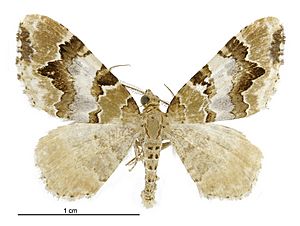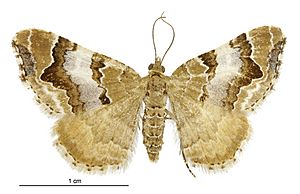Asaphodes obarata facts for kids
Quick facts for kids Asaphodes obarata |
|
|---|---|
 |
|
| Male | |
 |
|
| Female | |
| Conservation status | |
 Nationally Critical (NZ TCS) |
|
| Scientific classification | |
| Kingdom: | |
| Phylum: | |
| Class: | |
| Order: | |
| Family: | |
| Genus: |
Asaphodes
|
| Species: |
A. obarata
|
| Binomial name | |
| Asaphodes obarata (Felder & Rogenhofer, 1875)
|
|
| Synonyms | |
|
|
The Asaphodes obarata is a type of moth that belongs to the Geometridae family. This special moth is found only in New Zealand, meaning it is endemic to that country. Sadly, it is considered critically endangered by the Department of Conservation in New Zealand, which means it is at a very high risk of disappearing forever.
Contents
How Scientists Named This Moth
Scientists give unique names to all living things. This helps them study and understand different species.
The Moth's Original Name
The Asaphodes obarata moth was first described in 1875 by two scientists, Cajetan Felder and Alois Friedrich Rogenhofer. They first named it Cidaria obarata.
Where the First Moth Was Found
The very first moth specimen used for its description, called a holotype, was collected by Thomas R. Oxley. He found it in Nelson, New Zealand. Today, this important specimen is kept at the Natural History Museum in London.
How Its Name Changed Over Time
Over the years, other scientists studied the moth and changed its scientific name.
- In 1884, Edward Meyrick moved it to the genus Larentia.
- Then, in 1898, George Vernon Hudson placed it in the genus Xanthorhoe.
- Finally, in 1971, John S. Dugdale assigned it to its current genus, Asaphodes.
What the Moth Looks Like
The Asaphodes obarata moth is quite small, with its wings spread out to about 2.5 centimeters (1 inch).
Forewings (Front Wings)
- Its front wings are a pale grayish-yellow color.
- They have a broken reddish-brown band near the base.
- There are also two faint, broken, dark gray lines.
- These lines create a large central area on the wing.
- In this central area, you can see a clear black dot and some uneven dark gray marks.
- Beyond this, there is a wavy reddish-brown band.
- The tip of the wing sticks out a bit, and the outer edge is quite curved.
Hindwings (Back Wings)
- The back wings are pale gray.
- They have a lighter band in the middle.
- You can also see many faint, wavy, darker gray lines on them.
Cilia (Wing Hairs)
The tiny hairs along the edges of all the wings are white with dark gray bands.
Where This Moth Lives
The Asaphodes obarata moth is only found in New Zealand. This means it is endemic to this country.
Places It Has Been Found
Besides Nelson, where it was first discovered, this moth has been collected in several other places across New Zealand, including:
- Wellington
- Christchurch
- At the foot of Mount Hutt
- Waimarino
- Ohakune (in the North Island)
- Akaroa
- Otira
- Dunedin
- Queenstown
- Invercargill (in the South Island)
Where It No Longer Lives
Sadly, the moth's living area has shrunk in places like Dunedin and Southland. It is now considered locally extinct in both Dunedin and Invercargill. This means it used to live there but can no longer be found in those specific areas.
Moth's Home and Habits
This moth likes to live in certain types of places and is active during specific times of the year.
Preferred Habitat
- George Hudson noted that this moth could be found along the edges of forests.
- R. W. Fereday also mentioned that it is a species that likes open plains and has a special liking for gorse hedges.
When the Moths Are Active
Adult Asaphodes obarata moths are usually seen flying around in December and January.
What the Moth Eats
Scientists are still trying to figure out what plants the caterpillars of this moth eat. The specific host plants for this species are currently unknown.
Why This Moth Is in Danger
The Asaphodes obarata moth is in serious trouble.
Nationally Critical Status
Under the New Zealand Threat Classification System, this moth is classified as Nationally Critical. This is the highest threat level, meaning it faces an extremely high risk of extinction in New Zealand.
Main Threat
It is believed that the biggest reason this moth is in danger is because it is losing its natural habitat. This happens when the places where it lives are destroyed or changed by human activities.
Images for kids


